Primordial Evolution Game/Central Continent Desert: Difference between revisions
1d4chan>AwesomePoe |
m (36 revisions imported) |
||
| (15 intermediate revisions by 6 users not shown) | |||
| Line 1: | Line 1: | ||
[[Image:Desert_Progenitors.png|thumb|right|Desert Progenitors]] | |||
This page details the events of the desert in the [[Primordial Evolution Game|Primordial Evolution Game]] | |||
== Progenitors == | |||
Burrog: a descendant of the Glund. They burrow through the sand, omnivores they are. | |||
Sandoni: Descendants of the hive adoni, they have adapted to a solitary life and sucks plant sap or blood for a living. They also have those markings on their front legs to lure herbivores, like this sap over here. | |||
Usmal: Descendants of land flatworems. Yes, that's right, they're like fish living in the desert. Moving through the sand using their legs. Herbivores. | |||
Wespar: descendant of Wescks. They tend to fly at breakneck speeds and strike with uncanny percision and speed. Thank god they're solitary loners. | |||
Cho: Descendants of primitive Hrass, their leaves are waxy, and their flower glow in the dark. They send out lightweight seeds that also glow in the dark, to be carried by the wind. | |||
Kaskus: a descendant of Evola. It has hard spiky leaves at the bottom, and grow to great height to absorb enough sun from their skin. They also have gnarly, deep roots to tap into the underground water, and hard enough so they don't get chewed up by Usmals and Burrogs. | |||
== Wespar == | == Wespar == | ||
| Line 50: | Line 71: | ||
<br />progenitor: Burrog | <br />progenitor: Burrog | ||
<br />-> Loner Burrog | <br />-> Loner Burrog | ||
<br />-> | <br />-> Koburrog]] | ||
Some Burrog lost their horns for more streamlined and effortless burrowing They lived in small family groups for increased protection. The Social Burrog developed shallow groves in their armour plates to collect moisture during the night. Other Burrog drink this moisture off their fellows. They made small burrows and stored plant matter in them such as Cho pulps and Kaskus fruits. The social burrog developed longer legs, allowing them to move much faster. | Some Burrog lost their horns for more streamlined and effortless burrowing They lived in small family groups for increased protection. The Social Burrog developed shallow groves in their armour plates to collect moisture during the night. Other Burrog drink this moisture off their fellows. They made small burrows and stored plant matter in them such as Cho pulps and Kaskus fruits. The social burrog developed longer legs, allowing them to move much faster. | ||
Their tail spike developed into sensory organ. They held against the sand alert for worm vibrations. This gives them just enough time to start running and alert its mates. The social burrog developed better eyesight and a strong beak, so they might spot and eat on plant better. Due to the plentiful vegetation the Social Burrog grew larger and larger. They exhausted local vegetation during the dry season and migrated from oasis to oasis in large herds braving huge Sand Burrogs and ravenous Wespar Swarms. | Their tail spike developed into sensory organ. They held against the sand alert for worm vibrations. This gives them just enough time to start running and alert its mates. The social burrog developed better eyesight and a strong beak, so they might spot and eat on plant better. Due to the plentiful vegetation the Social Burrog grew larger and larger. They exhausted local vegetation during the dry season and migrated from oasis to oasis in large herds braving huge Sand Burrogs and ravenous Wespar Swarms. | ||
==== Koburrog ==== | |||
[[File:Koburrog.png|thumb|upright|right|top| | |||
<br />progenitor: Social Burrog]] | |||
==== Loner Burrog ==== | ==== Loner Burrog ==== | ||
| Line 180: | Line 205: | ||
==== Sniper | ==== Sniper Houzi ==== | ||
[[Image:Sniper_Houyi.png|thumb|upright|left|top| | [[Image:Sniper_Houyi.png|thumb|upright|left|top| | ||
<br />progenitor: Snake Houyi | <br />progenitor: Snake Houyi | ||
| Line 192: | Line 217: | ||
==== | ==== Artillery Houzi ==== | ||
[[Image:Devil_Houyi.png|thumb|upright|right|top| | [[Image:Devil_Houyi.png|thumb|upright|right|top| | ||
<br />progenitor: Sniper Houyi]] | <br />progenitor: Sniper Houyi]] | ||
The | The Artillery Houze became the largest of their species, Standing about three times as tall as any others. They lost the ability to spew spines, but gained the familiar tripod shape. They gained massive sword like arms to hack away at the most heavily armored of enemies. They do not prey on any other Houzi or Houyi. An entourage of the other Houyi species followed the massive Artillery Houzi into battle. The giant riped and destroyed and tanked damage from the defender, the smaller creatures launching spikes with impunity. | ||
==== Predator Houyi ==== | ==== Predator Houyi ==== | ||
| Line 219: | Line 242: | ||
==== Volcanic Houyi ==== | ==== Volcanic Houyi ==== | ||
[[Image:Volcanic_Houyi.png|thumb|upright|right|top| | [[Image:Volcanic_Houyi.png|thumb|upright|right|top| | ||
<br />progenitor: | <br />progenitor: [[Primordial Evolution Game/Central Continent Desert#Predator_Houyi|Predator Houyi]] ]] | ||
A subspecies of snake houyis emerged. The volcanic houyis adapted to live in the hot obsidian wastelands. They are smaller, more lithe than their cousins. To cope with the immense heat in these dark plains, they have developed lighter skin, that reflects sunlight. The volcanic houyi developed crests on their backs. The crests are supported by long hollow bones, which the creature can move up and down. The houyi use these crests to manage their body temperature. They raise their skin crests against the wind cooling their blood veins. They hunt the jet wespars which flock to these fields. They developed grooved spines making their shoots more accurate. The crests were used in mating displays and to communication. | A subspecies of snake houyis emerged. The volcanic houyis adapted to live in the hot obsidian wastelands. They are smaller, more lithe than their cousins. To cope with the immense heat in these dark plains, they have developed lighter skin, that reflects sunlight. The volcanic houyi developed crests on their backs. The crests are supported by long hollow bones, which the creature can move up and down. The houyi use these crests to manage their body temperature. They raise their skin crests against the wind cooling their blood veins. They hunt the jet wespars which flock to these fields. They developed grooved spines making their shoots more accurate. The crests were used in mating displays and to communication. | ||
==== Antlered Burrog ==== | ==== Antlered Burrog ==== | ||
| Line 330: | Line 351: | ||
==== Carnivorous Kaskus ==== | ==== Carnivorous Kaskus ==== | ||
[[Image:Carnivorous_Kaskus. | [[Image:Carnivorous_Kaskus.jpg|thumb|upright|left|top| | ||
<br />progenitor: Kaskus]] | <br />progenitor: Kaskus]] | ||
The Carnivore Desert Kaskus sunk its pitchers underground in order to trap unwary animals. It used water as a lure. As the animal descends the steep sides of the pitcher it falls, where the lids snap shut. The water in the trap is then sucked back for itself. The symbiotic Kaskus sandonis then wait for the animal to weaken and swarm from their tunnels to feed. Sandoni' digestion breaks the animals into simpler components that the plant can use. The sandonis also clear out indigestible matter from the bottom of the pitcher. | The Carnivore Desert Kaskus sunk its pitchers underground in order to trap unwary animals. It used water as a lure. As the animal descends the steep sides of the pitcher it falls, where the lids snap shut. The water in the trap is then sucked back for itself. The symbiotic Kaskus sandonis then wait for the animal to weaken and swarm from their tunnels to feed. Sandoni' digestion breaks the animals into simpler components that the plant can use. The sandonis also clear out indigestible matter from the bottom of the pitcher. | ||
==== Oasis Kaskus ==== | ==== Oasis Kaskus ==== | ||
| Line 353: | Line 372: | ||
The underwater KasKus shoots reached water's surface developing air bladders so that they floated. The underwater shoots developed a stronger base to anchor the tendril. They grew violet flowers to absorb additional light. The Flowers fold up at night to protect themselves. The flexiable tendrils develop inflatable water sacks along their length to manuver the flowers into position as sunlight changes. The flowers developed a slow color shift that occours through the span of twilight, shifting to a fully black coloration in an attempt to gather moonlight. | The underwater KasKus shoots reached water's surface developing air bladders so that they floated. The underwater shoots developed a stronger base to anchor the tendril. They grew violet flowers to absorb additional light. The Flowers fold up at night to protect themselves. The flexiable tendrils develop inflatable water sacks along their length to manuver the flowers into position as sunlight changes. The flowers developed a slow color shift that occours through the span of twilight, shifting to a fully black coloration in an attempt to gather moonlight. | ||
==== Kaskus Roostas ==== | ===== Kaskus Roostas ===== | ||
The root system becomes more advanced and searched for other large roots of nearby Kaskus plants to interconnect with. It developed larger, armored storage vacoules to protect from predators. | The root system becomes more advanced and searched for other large roots of nearby Kaskus plants to interconnect with. It developed larger, armored storage vacoules to protect from predators. | ||
| Line 362: | Line 381: | ||
Kaskus Roostas evolved to support further expansion and have developed attack roots tiped with quartz. When they discover a non-Kaskus root system they spear into it and begin assimilating the foreign plant. The Kaskus plant raided foreign plant systems. | Kaskus Roostas evolved to support further expansion and have developed attack roots tiped with quartz. When they discover a non-Kaskus root system they spear into it and begin assimilating the foreign plant. The Kaskus plant raided foreign plant systems. | ||
==== Kaskus Troopers ==== | ===== Kaskus Troopers ===== | ||
The body of the Kaskus developed as well. The tops of the sun-gathering shoots grew frail leaves out of its central shoot to gather even more sunlight. These wide leaves currently retract during the night. | The body of the Kaskus developed as well. The tops of the sun-gathering shoots grew frail leaves out of its central shoot to gather even more sunlight. These wide leaves currently retract during the night. | ||
| Line 504: | Line 523: | ||
Some of Usmal diverged to secrete a watery mucus which quickly dries sand into a hard material. Tall stalks can be found where they dig into the sand to make their homes. When Oasises disappeared during the dry seasons these sandcorals remained marking where the Oasis would return. In response to shifting sands, the muscus became stronger to support tall sand towers. Abandoned usmal tunnels made excellent shelter for other creatures while still young. Their bodies have became streamlined with a thinner body and eye-stalks which protrude forward. Their tendrils became dry and grew hair. By rubbing the them together, they create a high-pitch chirping noise, which is used for echolocation, in addition to a mating call. | Some of Usmal diverged to secrete a watery mucus which quickly dries sand into a hard material. Tall stalks can be found where they dig into the sand to make their homes. When Oasises disappeared during the dry seasons these sandcorals remained marking where the Oasis would return. In response to shifting sands, the muscus became stronger to support tall sand towers. Abandoned usmal tunnels made excellent shelter for other creatures while still young. Their bodies have became streamlined with a thinner body and eye-stalks which protrude forward. Their tendrils became dry and grew hair. By rubbing the them together, they create a high-pitch chirping noise, which is used for echolocation, in addition to a mating call. | ||
They developed a gland in their mouths that squirts their mucus. When their mucus contacts the air it quickly hardens to a flying pin. They fired these pins to deter predators. Their digestive acids mixed with these pins to irritate targets. | They developed a gland in their mouths that squirts their mucus. When their mucus contacts the air it quickly hardens to a flying pin. They fired these pins to deter predators. Their digestive acids mixed with these pins to irritate targets. In preparation to the mating season, Sandcoral usmals undergo a metamorphosis where they gain a pair of wings. They fly across the desert to find mates and a suitable location to lay their eggs. Every four months, the skies are filled with these them. They are nocturnal. | ||
==== Sandfish Usmal ==== | ==== Sandfish Usmal ==== | ||
| Line 530: | Line 547: | ||
<br />-> Tusmal]] | <br />-> Tusmal]] | ||
Some of the usmal became scavengers in the harsh desert and changed their color. They developed thicker legs to walk the sands. Their upper bodies grew shoulders and heads to watch for flying predators. To survive during the dry season, they developed water storing humps. Unforunately, these humps made they attractive targets for predators. They evolved facial mouths and teeth to better scavenge corpus. Usmal reproduction became controled by the Pusmal Queens. In time the Queens produced serveral sub-specsis by bio-engineering their own unborn. They evolved a pair of arms for their own advantage. They built walls to protect the nest from magma. | Some of the usmal became scavengers in the harsh desert and changed their color. They developed thicker legs to walk the sands. Their upper bodies grew shoulders and heads to watch for flying predators. To survive during the dry season, they developed water storing humps. Unforunately, these humps made they attractive targets for predators. They evolved facial mouths and teeth to better scavenge corpus. Usmal reproduction became controled by the Pusmal Queens. In time the Queens produced serveral sub-specsis by bio-engineering their own unborn. They evolved a pair of arms for their own advantage. They built walls to protect the nest from magma. | ||
| Line 562: | Line 568: | ||
<br />progenitor: Ambush Usmal]] | <br />progenitor: Ambush Usmal]] | ||
The Usmal evolved a frill like a satellite dish letting them hear long distances. It amplified their echolocation. The frills flex up and down. This emits sonic pluses blocking out heat and sound they produce. They grew bigger and slowed down their movement speed. They grew strong legs and backs. They started walking a on two legs. They use subsonic rattles to communicate over long distances. They began to live in tight packs that hunt and raise young together. | The Usmal evolved a frill like a satellite dish letting them hear long distances. It amplified their echolocation. The frills flex up and down. This emits sonic pluses blocking out heat and sound they produce. They grew bigger and slowed down their movement speed. They grew strong legs and backs. They started walking a on two legs. They use subsonic rattles to communicate over long distances. They began to live in tight packs that hunt and raise young together. | ||
[[Category:Primordial Evolution Game]] | |||
Latest revision as of 10:05, 22 June 2023

This page details the events of the desert in the Primordial Evolution Game
Progenitors[edit]
Burrog: a descendant of the Glund. They burrow through the sand, omnivores they are.
Sandoni: Descendants of the hive adoni, they have adapted to a solitary life and sucks plant sap or blood for a living. They also have those markings on their front legs to lure herbivores, like this sap over here.
Usmal: Descendants of land flatworems. Yes, that's right, they're like fish living in the desert. Moving through the sand using their legs. Herbivores.
Wespar: descendant of Wescks. They tend to fly at breakneck speeds and strike with uncanny percision and speed. Thank god they're solitary loners.
Cho: Descendants of primitive Hrass, their leaves are waxy, and their flower glow in the dark. They send out lightweight seeds that also glow in the dark, to be carried by the wind.
Kaskus: a descendant of Evola. It has hard spiky leaves at the bottom, and grow to great height to absorb enough sun from their skin. They also have gnarly, deep roots to tap into the underground water, and hard enough so they don't get chewed up by Usmals and Burrogs.
Wespar[edit]
Wespar[edit]
progenitor: Wespar
-> Fast Wespar
The Wespar developed fluorescents on their wings to attract mates. They evolved eyelids to protect their big eyes from desert dust. They developed a poisonous gland at the base of their tail blade. They used this stinger to incapacitate their prey. The poison has some acidic qualities. They layed their eggs in Kaskus plants, where their larvae feed and grow on the plant before metamorphosis. Afterwards they started injecting their eggs into other hosts.
Fast Wespar[edit]
progenitor: Wespar
-> Mach Wespar
A particular strain of Wespar replaced its wings with a highly modifed second lungs. They developed the Augmenter, a secondary pressurization organ which allows the wesper to reach high speeds. The Fast Wespar lived off of an extremely high caloric diet. Their digestive track terminated at the augmenter where waste is explosively flung out behind them. The gas vented out of their augmenters ignites controlled by chitinous plates. The plates control velocity, pitch, yaw, and roll.
Their tail became a stinger with a scalpel razor blade. Their hind legs atrophied. The Fast Wesper slept upside down anchored to plants or rocks. Hunting involved reaching top speed while stabbing and slicing thru a creature. The damage done to their prey is horrific and lethal. The Augmenter crys "Nanananana...." followed by the fast Wespar's kill shriek "YEAAAAAAAAHHH."
Mach Wespar[edit]
progenitor: Fast Wespar
The flying wespar underwent significant evolutionary changes. Their lifespan decreased 80%. Due to reproductive needs, they Mach Wespar travels in swarms. In a large swarm the Wespar take down larger prey. Their blood became a potent oxidizer and corrosive agent. Food is passed directly into a chamber filled with their blood. It is broken down and converted to energy. The waste is passed directly to the augmenters.
When a MachWespar nears the end of its life it will signals the swarm to hunt large prey to feast on. The Dieing Wespar will then begin a "Terminal Burn" violently ejecting its own blood through the augmenter. It reaches speeds too fast to track with the naked eye. Its victim has no warning as the Hate filled Wespar impacts its body at super sonic speeds. The impact force is enough to kill, the remaining blood explodes on impact.
Their females adapted a new method for reproduction. Female "Terminal Velocity" is slower than the males. A pregant female near the end of its life crashes in its victim. The victim is less likely to die from the impact, and the dead female releaves a phremonon that deters swarms from attacking. Those unlucky enough to survive soon die devoured from the inside by thousands of hungry Wespar larvae.
A sac under chin holds a reserve of highly processed blood. The Wespar sprays its blood out its mouth. Upon contact with air it ignites. Indivdually it is a small stream, but collectively it is very dangerous.
Burrog[edit]
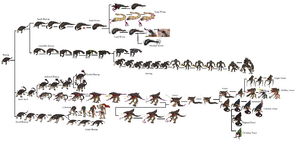
Horned Burrog[edit]

progenitor: Burrog
-> Sand Devil
The ancestors of the Sand Devils became more and more aggressive, and over time they all but abandoned feasting on plants, becoming full blown carnivores.
They had a powerful stinger they used to kill their prey. They hunted by night, burrowing themselves under few layers of sand, waiting for the prey to come close, upon which they burst from their hiding place and charge the prey.
Social Burrog[edit]

progenitor: Burrog
-> Loner Burrog
-> Koburrog
Some Burrog lost their horns for more streamlined and effortless burrowing They lived in small family groups for increased protection. The Social Burrog developed shallow groves in their armour plates to collect moisture during the night. Other Burrog drink this moisture off their fellows. They made small burrows and stored plant matter in them such as Cho pulps and Kaskus fruits. The social burrog developed longer legs, allowing them to move much faster.
Their tail spike developed into sensory organ. They held against the sand alert for worm vibrations. This gives them just enough time to start running and alert its mates. The social burrog developed better eyesight and a strong beak, so they might spot and eat on plant better. Due to the plentiful vegetation the Social Burrog grew larger and larger. They exhausted local vegetation during the dry season and migrated from oasis to oasis in large herds braving huge Sand Burrogs and ravenous Wespar Swarms.
Koburrog[edit]
progenitor: Social Burrog
Loner Burrog[edit]
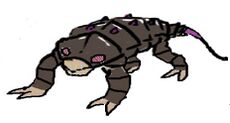
progenitor: Social Burrog
With the lack of reliable vegetation the large herds of Social Burrog became rare. They became even larger and developed armour plates over their limbs to deter predators. They uprooted plants to eat their roots. The loner Burrog gained ultra-violet eyes, enabling them to 'see' the light reflected from the carapaces of the many deadly insects which now patrol the desert. This gaves them time to react by fleeing or digging into the sand.
Armadillo Burrog[edit]

progenitor: Burrog
-> Gorrirog
Some burrogs who lost their horns began to curl up in to a ball, so that they might roll down the dunes. This adaptation was quite efficient for escaping potential predators, as they could get far away from its assailant by rolling. They had enhanced hearing as well. These mutations gave it time to burrow under the sand before the predator could reach it again. The Armadillo Burrogs developed small armoured plates for protection and improved rolling. They developed longer claws for digging nests. Eating the Iron-rich Kaskus roots improved their armor and claws with dense iron.
The Armadillo Burrog developed small nodules on its shell plates, these contain chemicals that can produce small bursts of electricity. The nodes are charged from either rolling around or basking in the sunlight, and the electricity is released when the burrog feels threatened. The iron compounds from the Kaskus improved these nodules to produce a lethal wall of energy. They left their burrows to travel in herds across the desert.
Gorrirog[edit]

progenitor: Armadillo Burrog
The Greater Armoured Burrog lost some of its joint shell, and its back developed to stand upright. It developed paws to swipe at things, before evolving proper prehenisle hands. With their strong forearms they can even uproot trees.
The volcanic activity has activated the long dormant metal bio-electrical nodes in their shells, causing them to constantly release sparks of electricity. This has also made them more aggressive as a species, the once lumbering giant herbivores now fight amongst each other
The once docile herbivore Gorrirogs are now aggressive omnivores, smashing smaller animals to a pulp with crude tools or their bare hands. Metallic studs have protruded from the knuckle bones. The largest of the Gorrirogs will sometimes lead a small "pack" of them to take out more deadly prey
The Gorrirog has developed compound eyes to better protect itself from all the airborne death that's evolving around it. Becoming even more violent it has become almost completely carnivorous, preying on anything it can find, mostly the varieties of Usmal. They can now channel the bio-electricity at will (to some degree), and it is released from the metallic nodes on their shells
The Gorrirogs develop conductive nodules on their palms and fingertips. Even unarmed the gorrirog can grab and shock prey. Over a few generations, Gorrirogs discover that certain materials are better weapons than wood and rocks with traces of metal become commonly used
The Gorrirog grow in strength and stature, able to hurl stones with incredible force at flying assailants. Shockpoints grow on areas of frequent usage. The social hierarchy of gorrirogs continues toward the trend of alpha leaders, as the strongest and most durable assert themselves on their subordinates.
Frequent use of electric pulses leads the Gorrirog to develop specialized organs located on their tail. These organs enhance the already formidable capacity of the gorrirogs. This leads to the ability of gorrirogs to project the electricity over a short distance. the prevalence of rock-wielding tactica leads to some of the more cunning gorrirogs to develop a tactic
Spade Burrog[edit]

progenitor: Burrog
-> Sandworm
-> Oasis Worm
The Burrog body became more worm like. It's hind legs and eyes atrophied completely. It's front legs became powerful spades. Its head plates grew larger hiding the creatures mouth under them. They open when the Worm Burrog feeds, revealing its teethed maw.
Sandworm[edit]

progenitor: Spade Burrog
-> Giant Sandworm
The Sandworm developed pressure sensing organs allowing them to sense vibrations traveling trough the sand. They began hunting surface creatures by tracking their vibrations. They grew quite large.
They developed specialized muscles right underneath their armor plates. These muscles constantly undergo micro contractions. This causes the armor plates and the sand around them to vibrate. The Sandworm swiftly burrows through the sand. The pressure sensitive organs filter out vibration from these muscles.
This caused the worm to become vulnerable to vibrations near its own frequency. They suffer from senory overload from other worms. Worms avoid each other except during reproduction.
To circumvent this overload, the worms have developed a reproductive tactic. The males lay a slowly pulsating "egg" that contains their sperm. These eggs pulsate with a certain frequency, drawing the females near them. When they find these eggs, they devour them and inseminate themshelves The female lays proper eggs afterward.
Giant Sandworms[edit]
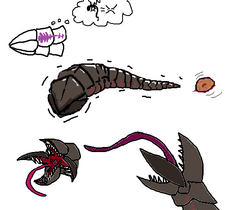
progenitor: Sandworms
The forelimbs of sand worms developed into a secondary jaws. The muscles responsible for the vibrations also developed to produce more power. The sand near the creature is like water. They essentially swim trough the sand. They developed long muscular tongues, that allow them to catch prey after the initial surprise attack. The mighty sandworm reached near perfection its ecological niche. The only major change in body structure is the development of fangs in the secondary jaws.
The sandworms can grow into immense size, easily weighting many tons. Eventually, these worms starve to death in old age. Moving becomes inefficient as they grow in size. They grow their whole lives, young being more active than old. They feast and grow, storing away massive amounts of fat under their armored skins. Their active lowers until they just lay eggs. They take opptunistic prey but rarely move.
While they are young there is still competition between Houyi and Wespars. Their brains developed to learn hunting tactics. At their height junviles learn fast, adapt fast, and think fast. As they grow old their ability to learn is greatly diminished. But their memory remains.
LandWorm[edit]
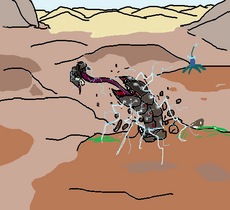
progenitor: Sandworm
-> Obsidian Worms
Landworms developed to penatrate hard ground. They became smaller, and developed hard metal bumbs to vibrate at even higher frequencies. These vibrations generated static electricity which are channeled through the metal bumbs. Electric buildup is released when the worm brusts from the ground, and stuns or kills prey. These land worms burrowed through rock. In looser soil, such as plains and similar areas, they were as deadly as the sand worms. They developed a tongue pincher, which allowed them to firmly hold their prey. Worms fish for prey by leaving their tongue exposed on the surface. The tongue lunged at prey conserving the energy needed to burst out of the ground. The high frequency vibrations of the worms generate massive amounts of static electricity (applies to the sandworms as well), but on land worms, the electricity is channeled, although not in a controlled fashion, through the metallic bumbs on the worms carapace.
Obsidian Worms[edit]

progenitor: Landworm
After the Volanic explosions, Some landworms adapted to the obsidian plains. They tunneled trough the brittle rock. They developed a quake organ on their tails. This organ is covered with metal and string vibrating muscles. These organs generates a earthslide under the feet of prey. They prey fall to their deaths and into the worm
Oasis Worms[edit]

progenitor: Spade Burrog
The oasis provided a completely new environment for sandworms. The complex root system forced worms to grow smaller to move around. They adapted to the water, flailing their tail to swim. They surged from the water and caught drinking creatures. They evolved gills. The pressure sensitive organs became sensor organs. These organs track the worm vibrations and how they bounce back from the environment. Their tongues developed three strong tips, that allowed them to grab prey from afar. In response to the dry season, the worms burrowed under the mud, reinforcing these burrows water sealing mucus. They hibernate waiting for the next rainfall.
Sand Devils[edit]

progenitor: Horned Burrog
-> Houyi
The ancestors of the Sand Devils became more aggressive and became full blown carnivores. They developed a powerful stinger they use to kill their prey. They hunt by night, burrowing themselves under few layers of sand, waiting to ambush prey. It sprays its poison and injects it with greater force and volume. Unhinged mouth and long rolling tongue for horrible nightmare fuel seeds.
Houyi[edit]

progenitor: Sand Devils
-> Snake Houyi
The Houyi developed 180 degree light and inferrad vision, which they use to hunt the cloaked Usmal at night. Using their stabilizing peg, they charge forward as they unhinge their to rip prey to shreds. As the Houyi started to prey on larger more agressive creatures, They lost their horns but developed a rear spike. Their replaced its upper endoskeleton with cartilage. This allowed the beast to unhinge its toothy jaw to horrific proportions.
By eating and compressing sand then coating it in mucus the Houyi creates sand javelins. To launch them, it "sneezes" at the target. The projectiles fly far and in a large cluster. They developed a hollow back carapace to store up to 40 javelins.
Their balance shifted. Their legs adapted for running and jumping, while their back blade adapted into a tail that helps stabilize the creature. Their ankle claws developed joints, allowing the creature to move them. This was helpful for the young houyi, as it allowed them to climb around easier. They Houyi pounces at prey using its powerful legs. Their tongue became longer, stronger, and more dexterous. They used it to grab and constrict other creatures. When running, the tongue is folded neatly inside their massive maws.
Snake Houyi[edit]

progenitor: Houyi
-> Predator Houyi
-> Sniper Houyi
A splinter species of the Houyi emerged. Their forelimbs were used to stabilize the creature while it slithered around on their strong tails. They lived at the base of mountains, where the warm thermal winds blew. The jet wespar flocked to these areas. The Houyi specialized to hunt these small fliers. They tilt their bodies upwards in order to shoot at the flying critters. Their tails grew and gained strength to support the creatures weight. They developed lungs with extremely powerful muscles under their carapace. The lungs generate immense air pressure to fire their spines.
To channel these spines, they developed a sturdy muscular tube, that extends under their topmost jaw. The spines are lubricated by poisonous mucus when they are squeezed through this tube at great speeds. The tube allows the creatures to be extremely accurate with their spines, easily being able to hit targets several hundreds of meters away. They shot down and ate Wespar.
The devils adapted to the new Wespar maneuverability by further developing their spine shooter organ. Their javelins grew smaller but were launched with greater speed. Because of their small size, the devil could spit these shards faster, and store up to thousand of them.
They lived in small colonies and are mostly inactive waiting for a wespar swarm to use the thermal winds. When the wespars arrive, they spray the air with shards, each one focusing on their own area of the sky. They fight viscously over food, the strongest eating first.
When the Wespar countered with smoke screens, they were forced to hunt other creatures. Using their range and numbers, They can kill with sand-spines fast, allowing them to hunt bigger creatures. These hunting packs have started migrating from the mountains to the plains and the arid edges of the deserts. There is a strict hierarchy within the group. The strongest male leads them, eats first and gets the females. Disputes between the creatures are settled with duels, fought with their arm blades.
Sniper Houzi[edit]
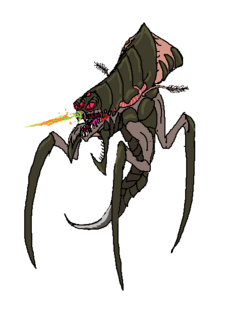
progenitor: Snake Houyi
-> Devil Houyi
The Houyi suddenly grew a third leg. They gained such benfits as the ability to stretch up high and see over small obstacles, thus delivering their deadly barrage more effectively. Their carapace sticks out like a shark's fin. They became ambush predators, lurking under the sand or in the cover of rocks. They burst only when prey passes by. They use their tails to dig their ambush burrows. They moved by quickly skittering over rocky terrain, or propelling themselves with their tails on dunes. They prefer the rockier areas, as their body structure makes it quite hard for them to move in sand.
They developed acute eyesight, as well as powerful extra air-sacks to their pressure lungs, allowing them to propel javelins far. The sniper houzi developed a pair of antennae like appendages, that allow it to sense air currents better. Their accuracy increases. They hunted by stalking their prey and sniping, quickly skittering to their kill to devour it. To deter predators before they arrive at the corpus, the lubricant mucus their javelins used were horrible to smell and taste. They used their sharp tail blades as well as to deter other predators.
In the plains, flouz creatures were their favored prey. They were easy to pop and follow as they fall. Elsewhere Their main food is once again, social burrogs.
Artillery Houzi[edit]

progenitor: Sniper Houyi
The Artillery Houze became the largest of their species, Standing about three times as tall as any others. They lost the ability to spew spines, but gained the familiar tripod shape. They gained massive sword like arms to hack away at the most heavily armored of enemies. They do not prey on any other Houzi or Houyi. An entourage of the other Houyi species followed the massive Artillery Houzi into battle. The giant riped and destroyed and tanked damage from the defender, the smaller creatures launching spikes with impunity.
Predator Houyi[edit]

progenitor: Snake Houyi
-> Volcanic Houyi
The snake houyi were out-competed in brute strength and speed by the running houyi almost everywhere. The little advantage the snakes had was their relatively more accurate spines and longer range. Unlike their running cousins, the snakes couldn't just ram a tankdoni while shooting few javelins at it, and expect to succeed in bringing the acid spewing bug down. No they had to think what they were doing.
Slowly, but surely, a predatory cunning like no other started developing within their brains. The concept of tactics, covering fire and flanking were slowly sinking to the minds of these ravenous predators.
The snake houyi hunt in packs with almost military grade organization. Each individual has clear objectives and roles when they hunt. One distracts the prey, while other moves to its flank, as the rest of the pack provide covering fire with their spines, pinning the prey to the ground, allowing the flanking one to either unleash a volley of spines to the creatures unarmored backside, or simply move close enough to be able to swiftly kill the victim with it's arm blades.
There is clear, cold and calculating mind lurking within the armored head of these beasts. They know when and when not to attack, they make plans, ambushes, raids. They capture creatures to their lairs, presumably for feeding their young. They are predators, first, sentients second. There is no compassion in them, the weak die and the strong endure.
Some houyi begin to use the caverns and otherwise already loosened soil that the landworms have created to build their burrows in. Their front claws become sturdier, to help them dig, and their tail starts excreting resinous substance, that they use to harden the walls of their lairs. They also become somewhat smaller. The digging houyi live in bigger groups than their larger cousins. The group is led by the ruling male and female, who have the privilege of reproduction. The rest of the individuals of the pack are their descendants.
The landworms are a problem to them however, as they can easily breach their burrows. This is why their lairs aren't permanent bases, instead the houyi are constantly ready to move out, in case they feel the tell tale vibrations and the static buildup that signal the arrival of a landworm. They quickly abandon their nests, sometimes intentionally crippling the weak, sick or the elderly to buy time for the rest of the brood as they make their escape.
Volcanic Houyi[edit]

progenitor: Predator Houyi
A subspecies of snake houyis emerged. The volcanic houyis adapted to live in the hot obsidian wastelands. They are smaller, more lithe than their cousins. To cope with the immense heat in these dark plains, they have developed lighter skin, that reflects sunlight. The volcanic houyi developed crests on their backs. The crests are supported by long hollow bones, which the creature can move up and down. The houyi use these crests to manage their body temperature. They raise their skin crests against the wind cooling their blood veins. They hunt the jet wespars which flock to these fields. They developed grooved spines making their shoots more accurate. The crests were used in mating displays and to communication.
Antlered Burrog[edit]

progenitor: Horned Burrog
Some Burrong migrated to areas with more vegetation and less prey and became herbivores. Their horns adapted, now used for duels and impress females. Its poisonous sting transformed into a mace to ward off predators rather than a weapon to hunt. They also became bigger. Some Burrog developed a tube to eat insects and access wells easily. With time, these burrogs developed new thumbed hoofs which improve digging roots and stuff, the antlers were reduced and a tusk started to appear. They lived in good sized herds, but the vicious predators made their lives very difficult.
Cho[edit]
Small Cho[edit]
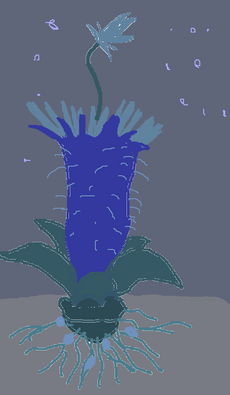
progenitor: Cho
The Cho leaves began to grow thicker and shorter, holding in more fluids. Their flower developed a stalked blossom to further aid in wind dispersal of seeds. It developed tubers, that allow it to store more nutrients and energy in case of a disaster. The plants grew taller, and developed protective hairs, which irritate potential herbivores.
Creeper Cho[edit]

progenitor: Cho
-> Spike Cho
-> Minic Cho
-> Oasis Cho
With the new Oasis came, the a new strain of cho, the creeper cho, grew widly and spread around them. Its leaves grew longer and more rubbery so it could take being stepped on. Its spores shot out with any disturbance.
Spike Cho[edit]

progenitor: Creeper Cho
-> Umbrella Cho
Reacting to the increase in predators, the cho evolved a hard underside made of interwoven fibers and excess minerals found underground mineral traces. When it is threaten, it immediately wraps itself in hard spikes difficult to break through and difficult to digest. The Spike Cho developed larger roots along their leaves to support the leaves and lift them in case the area gets too hot, providing a way to cool the area around them. These roots were filled with fluid and became spikes to deter predators. The spiked Cho developed a extensive root system to search for deep water sources. Their underside became harder and the spike became larger and hooked to case more pain if impaled upon.
Umbrella Cho[edit]

progenitor: Spike Cho
The Cho hit the evolutionary motherload and make a series of quick advancements and adaptations.
The central spire formed an umbrella structure over itself. It is hard and armoured, made of interwoven fibers with iron strains to protect itself from the bombs of the Albatross Cho. Underneath this umbrella, sandwiched inbetween layers of plantfibers are great waterpacks the Cho can rely on in droughts. The creeping vines grew longer and stronger, able to support the weight of most creatures.
When there is a great threat, the umbrella locks up and the vines wrap around it forming a series of walls, the rubbery inside absorbing kinetic damage and channeling it into the ground.
Periodicly the Umbrella Cho shoots out great spore clouds that bathe the desert in it's bio-luminecence. And every night the light refracted through the waterpockets forms a rainbow lightshow to be seen around the plant as it bathes itself in a light mist, washing off any detrius that may settled. They now grow around seasonal or permanent water sources.
Lastly they have began to produce varying colours for their bioluminecence, changing throughout the day to match with their mineral content, temperature, water content and general health.
Oasis Cho[edit]

progenitor: Creeper Cho
An offshoot of the creeper cho expands into the oasis water itself. It's long leaves allows it to float and drift with the currents. They grew larger due to a lack of predators, and become a habitat for the Aquatic Usmals, who use the large leaves as basking spots and as refuge from the Gill Worms. Their natural camouflage keeps them mostly safe from the Amphibious Waspar. They feed on the floating Kaskus shoots which gives them a source of metals for future evolution. In response to Kaskus water flower, they have developed flammable sap which they inject into targets using two specially developed root tendrils. Too slow to hit creatures but fast enough to attack other plants. The Aquatic Usmal have developed a small crest on their heads which flushes with blood when an Usmal senses danger, sending the group diving into the safety of the Submarine Cho's chamber.
Mimic Cho[edit]

progenitor: Creeper Cho
An interesting strain of cho develops, the mimic cho. In its normal state, it looks like cho in every way mimicing all the various strands including tall cho, creeper cho, spiked cho and water cho. The only immediately obvious difference between a real plant and a mimic appears after the mimic has feed. It's main bulb turns red with the blood it stores after draining a creature. The other difference is its reaction to touch. After a few seconds it will snap close wrapping up any creature, crushing them with it's powerful leaves. Its underside has woven together in a tighter formation including metallic strains for support. The 'spore pods' on the upperside are actually spikes that impale creatures and rips it apart as the inner walls undulate and the outer walls squeeze. They showered its spores on the real plant. When the real plant releases their spores it also spreads the Mimic.
The Mimic cho developed a sensitivity to sound to sense creatures that pass nearby. A hard spike in their core shoots at the creature by wrapping up in a fashion similar to the spiked cho.
Kite Cho[edit]
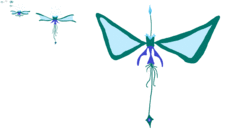
progenitor: Cho
-> Albatross Cho
In this new species a thin leafy membrane grew from the Cho bulb to the waxy leaves. In severe sandstorms this membrane lifts the Cho into the sky. From this height the Cho has no fear of predators and receives access to sunlight. However the Flying Cho is unable to develop the metal defenses of their cousins.Their spores spread wider in the sky. The Cho stores water in its blue base. The "wings" become more rigid becoming more resistant to damage. The root ball simplified for quick uprooting, and became a cluster of vine-like tendrils that move quickly to sop up water.
The aerial cho began to use their tendrils as kite tails. Their "wings" developed the ability to flex catching more wind. Aerial cho glide for days after a sandstorm subsides. The aerial cho developed its wings to take advantage of thermal updrafts. Using these updrafts they glide for days after its initial launch. The bulb developed distal canards to help its balance. Since they were not apart of Wespar diet, the aerial cho fly alongside Wespar swarms. When their blossoms brust, they cover a wespar in spores to be carried to new territory.
Albatross Cho[edit]

progenitor: Kite Cho
-> Dragon Cho
The plants developed a massive wingspan, and supplementary structures grow to support the huge wings. Cells along the caudal vines sucked moisture from the air around them, negating the need to absorb water from the ground. These cells also picked up trace minerals from wind-blown sand. Their seedlings are planted on corpses by hunting wesper. Their rudimentary chemical processes steer them towards pockets of humid air.
The albatross cho have developed true flight. Young wait for a strong gust to become airbrone. If grounded their is a greater chance to fly again. They gained greater control to vary its altitude. With Wesper swarms bcoming difficult to follow, the species developed a new reproductive stratgey. The species developed a flammable sap that is incredibly volatile. The unstable sap is bundled within newly adapted spore pods. These pods were fireproof and specially shaped to steady their fall when dropped from the parent's bloomshell.
when a sporebearing adult senses an increase in humidity in the air, such as would be produced by evaporation from an oasis, it releases its hellstorm of explosive sporepods. the first to impact burn through any local flora or fauna unable to escape the blaze, while those who come late are left with pre-fertilized ground to take root in. In the presence of ash and nutrient byproducts of their new method of reproduction, They developed much stronger structures around the bases of their wings. These new structures allowed for powerful flexing of the wing structures.
Dragon Cho[edit]

progenitor: Albatross Cho
Due to predation by the carrier wespar, the albatross cho evolved to avoid the swarms. They developed additional wing structures and sinuous flexor tissue. This addition allowed them to reach heights exceeding 40km. To cope with the air pressure and alot of ice, the albatross cho have adapted a strange behavior. Their formerly weaponized sap drains constantly from their seedheads. Their jaws clap rhythmically to cause bursts of heat to melt ice crystals. The moisture is absorbed further down the body by the multitudinous root-vines along the plant's posterior edge.
Kaskus[edit]
Kaskus[edit]

progenitor: Kaskus
-> Armored Kaskus
-> Carnivorous Kaskus
The Kaskus developed fruit to entice Burrog and Usmal to disperse their seeds. The Kaskus developed a hollow gourd and retractable lids to better preserve water. The kaskus developed pores that secreted sweet nectar so that kaskus sandonis living on it will protect the plant aggressively. The kaskus and the sandoni have formed a symbiotic relationship. The kaskus adapts to grow in the water rich environment of the oasis. As the water is now easily reachable, the hollow space inside is repurposed as a nest for the sandoni. The lids at the top of the holes now close and open when the sandoni tap them.
Armored Kaskus[edit]
progenitor: Kaskus
-> None Known
In response to the social burrogs grazing the oasis kaskus, they develop armoured trunks using the mineral deposits. The central pitcher became dominant and the sides snrunk away. The kaskus sandoni live inside this central pitcher. They are forced to hibernate during the dry season only blooming when the season changes. It's symbiosis with the Kaskus Sandoni has come to and end, no longer feeding them nectar.
Carnivorous Kaskus[edit]

progenitor: Kaskus
The Carnivore Desert Kaskus sunk its pitchers underground in order to trap unwary animals. It used water as a lure. As the animal descends the steep sides of the pitcher it falls, where the lids snap shut. The water in the trap is then sucked back for itself. The symbiotic Kaskus sandonis then wait for the animal to weaken and swarm from their tunnels to feed. Sandoni' digestion breaks the animals into simpler components that the plant can use. The sandonis also clear out indigestible matter from the bottom of the pitcher.
Oasis Kaskus[edit]

progenitor: Kaskus
-> Kaskus Flowruts
-> Kaskus Roostas
-> Kaskus Troopers
Kaskus developed internally over time in large oaisi. Their exposed elements developed strong fiberous skin. The roots extended their reach, using small root tendrils to crack the ground, exploring deep for resources. The tendrils surrounded a resource and engorged. They acted as a super-highway bringing the resource to the main body of the plant. The Kaskus shifted their fruit bearing roots closer to the surface discouraging herbavores from digging the plant up.
KasKus reinforced their outer limbs with new mineral deposits with fibers reinforced by copper and iron. The shoots of the plant grew in height and size bringing more sunlight in for energy. Its fruit surfaces further away making it much more attractive than uprooting the plant. Spikey leaves at the bottom grew in number and developed sharp tips using recovered ore. The KasKus developed de-centralized storage, keeping additional water and metal resources in large vacoules further underground.
Due to the stress of assimulating and exspanding the hivemind develops the Kaskus Naruiv. Located deep within the earth this Kaskus component handles the rudimentry chemical-driven inteligence of the hivemind and facilitates processing information and responding to threats throughout the network of connected Kaskus and assimilated plants.
Kaskus Flowruts[edit]
The underwater KasKus shoots reached water's surface developing air bladders so that they floated. The underwater shoots developed a stronger base to anchor the tendril. They grew violet flowers to absorb additional light. The Flowers fold up at night to protect themselves. The flexiable tendrils develop inflatable water sacks along their length to manuver the flowers into position as sunlight changes. The flowers developed a slow color shift that occours through the span of twilight, shifting to a fully black coloration in an attempt to gather moonlight.
Kaskus Roostas[edit]
The root system becomes more advanced and searched for other large roots of nearby Kaskus plants to interconnect with. It developed larger, armored storage vacoules to protect from predators.
Kaskus developed an interconected root system. A primative hive mind driven by chemical interaction allowed the plants to share the contents of their armored vacolues. When two large interconnected plant systems connect a breif negotiotion period occours while assets are collaborated. Smaller plant systems are absorbed. This sharing of resources allows Kaskus plants to grow their less developed neighbors quickly and facilitate the Kaskus plants expansion away from the oasis.
The KasKus Roostas reinforced critical root systems with metal to provide resilance against predators. Fruit bearing roots surface to entice herbavors as prey for the Wespars.
Kaskus Roostas evolved to support further expansion and have developed attack roots tiped with quartz. When they discover a non-Kaskus root system they spear into it and begin assimilating the foreign plant. The Kaskus plant raided foreign plant systems.
Kaskus Troopers[edit]
The body of the Kaskus developed as well. The tops of the sun-gathering shoots grew frail leaves out of its central shoot to gather even more sunlight. These wide leaves currently retract during the night.
The outside of the shoots grew large hooked thorns. Providing a landing spot for creatures to pearch. The Kaskus developed a bitter alkiline sap that it secretes at the tips of its spines. The Spines grew longer with additional rows from the root system to furter prevent predator intrusion.
The shoots reinforced and reshaped their retractable leaves, making a more geometric pattern. In responce to predatation on outling Kaskus, the evolved to support Wespars. The openings on top create a curved lip trough around the outer edges. The Kaskus plant fills this trough with nutrients favorable to Wespary. They also grews stamens that release attractive perhormones.
The Kaskus's relationship developed further. Their Tooper leaves provided a nesting place for the Wespar using metal reinforced hooks. The Kaskus's perhoromone emmiters evolved to signal Wespar hordes in cause of imminant threat. Kaskus developed additional feeding troughs.
Sandoni[edit]
Gliding Sandoni[edit]
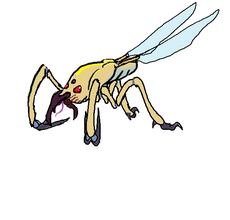
progenitor: Sandoni
-> Flying Sandoni
Sandoni developed pits along their 'snout' that detect concentrations of CO2 to pinpoint breathing prey. They developed powerful spring like back-legs that allowed them to jump. Their front legs grew claws. With it's powerful hind-legs, it can pounce its prey from afar and kill it swiftly. Their dorsal developed into winglike appendages, allowing them to glide from dune to dune. They developed strong muscles under their proto-wings to increase hover time. The proboscis grew into a hard beak. It was effective at piercing the hard shells of the burrog. Their eyesight improved.
Flying Sandoni[edit]

progenitor: Gliding Sandoni
-> Oasis Sandoni
-> Swarming Sandoni
The Sandoni evolved for flight. They used their powerful legs to propel themselves high in the air, allowing them to easily gain air. They started hunting the social burrog herds in agile packs. They outmaneuvered and ponced their targets ripping them with their claws. They fly high to spot their prey. Many ground predators such as the sand devils have learned to follow thes flying because when they land there is bound to be food. With their acute sight, they watch out for the wespars giving them time to land and reach cover.
Swarming Sandoni[edit]
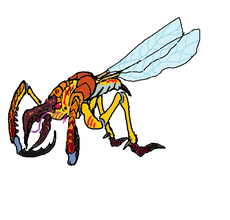
progenitor: Flying Sandoni
This sub species lived in large groups. They flied over the dunes in constant search for prey. They communicated trough chirps and pheromones. When one finds prey or when one dies, it starts to "scream" calling all his mates to itself. They emited a cloud of pheromones that frenzy the sandonis causing them to blindly attack the threat. The swarming rippers developed hollow armor plates that increase their survivability in their frenzied hunts. The armor's strength comes from it's honeycomb internal structure, which can absorb great blows.
Oasis Sandoni[edit]
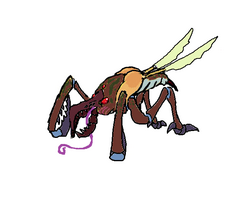
progenitor: Flying Sandoni
-> Blade Runner
Another subspecies emerges from the ripper sandonis. The sandonis living in the oasis lost their ability to fly, instead they grew larger almost four times as their progenitors. Their powerful jaws ripped trough the protective shells of the burrog creatures attempting to drink from the oasis. Their tongue grew longer and becomes more muscular, allowing them to grab prey easier. Their wings completely atrophied.
Blade Runner[edit]

progenitor: Oasis Sandoni
These Sandoni developed longer legs. They run extremely fast in rockier environments but are ill suited for the actual desert. They grew bigger and faster but unsuited for the dunes. These creatures hunt on the arid plains surrounding the desert, and in the rocky terrain of the canyons and mountains. The blade runners developed many sharp blade arms. They hunt by impaling their victims with their arm blades. Their wings have atrophied. The remains of their wings developed into a jointed appendages that helped the creature balanced. Their stinger developed into a long pole for balance as well. The blade runners developed additional blade arms. The tip of their tail split in two, and within tips are special veins, in which flows fluids. This organ gave the creature a heightened sense of balance.
The blade runners became more social hunting in packs, surrounding and outmaneuvering their prey, before violently cutting them open. They communicate with chirps they produced by rubbing their twin tails together. Hard and small chitin spikes developed on the inner sides of both tail tips, allowing the creatures to produce louder chirps.
They started moving with swarming rippers. The smaller rippers fly and scout for prey, while the bigger blade runners can kill far bigger prey than their smaller cousins. Together they form a hordes of claws, teeth and chitin. When the horde attacks, the smaller rippers distract biting ankles and other soft parts. The bigger blade runners use the distraction to strike. They impale their prey to their forelimbs, while slashing them with their secondary arm blades. They use their strong beaks to crush the creatures harden armor.
Kaskus Sandoni[edit]
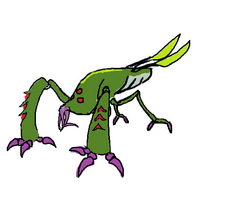
progenitor: Sandoni
-> Army Sandoni
Some sandoni adapted to live near the kaskus plants. Their coloration changed to match the plant. They developed sturdier mouth parts that allowed them to feed on the plant. Their front legs became larger, and the sap glands in their legs developed to spray irritating substances towards potential threats and competitors. They developed claws to climb the Kaskus plant enabling reach softer parts of the Kaskus plant. They grew more sociable. Multiple kaskus sandonis share the same kaskus plant, and fiercely protect it against herbivores such as social burrogs. The spurs on their back developed into colored fins.
Army Sandoni[edit]

progenitor: Kaskus Sandoni
-> Tank Sandoni
As The symbiotic relationship between the sandoni and kaskus plants died out everywhere except the most permanent oases, the sandoni were forced to adapt. The nomadic sandoni groups began to move in search of food. They used their acid sprayers to bring down prey or drive away predators. These creatures unleash massive volleys of caustic thick fluids that burn the flesh, blind the eyes and cause pain so great that it can paralyze creatures. Their mouth parts changed to suit their now omnivorous diet. These rowing bands of sandoni hunt effectively in smaller groups. When these groups gather together, they form massive armies that migrate from oasis to oasis. Their eyesight and spary accuracy developed further. Their hind legs became sturdier, in order to better handle long marches.
Tank Sandoni[edit]

progenitor: Army Sandoni
A bigger verison of the Army Sandoni. The tankdoni developed even sturdier armor. Their mouth parts become more better suited for multitude of diets and their color changes to suit more rocky environments.
Cho Sandoni[edit]

progenitor: Kaskus Sandoni
-> Cultivator Sandoni
Due to the predation of Burrogs on the Kaskus Sadoni and their homes, an offshoot of the Kaskus Sadoni evolved a new pair of forelegs. This allowed the larger existing pair of forelegs to be strengthened and used both an offensive and defensive mechanism. Also this new Sandoni offshoot leaves the sudden bustle of the oasis and begins to find homes among the Cho plants.
Their new diet and habitat caused the Cho Sandoni to change their coloration to better fit their new homes. The Sandoni's large pair of forelegs became more and more articulated and dextrous. Mostly inhabiting the larger versions of Cho, small groups lived in the same plant and protected the plant from other herbivores created a symbiotic relationship.
With the need to find water becoming a little more prevalent, a new caste developed in the original strain. The "Scout" caste developed wings in order to fly in search of water, and their bodies have been expanded to store extra water to hydrate them on their reconnaissance runs. The working class cho emerged to build and move new materials. Their claws were replaced with edged prongs for grip. They gained more muscle to carry heavier loads and developed two extra arms.
Cultivator Sandoni[edit]
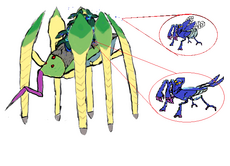
progenitor: Cho Sandoni
The cultivator Sandoni that colonized the leaf sandoni and Titandoni did not physically changed much, though they gained a greater ability to learn and a rudemntry language. Through a series of clicks and chirps that can convey simple information. They've learned to be picky in which Titandonis they colonize, picking only the very largest and least likely to be killed by a predator. The Titandonis benefit from the extra care and aid in finding water. The cultivator sandoni introduced new strains of cho to the Titandonis' back. The most succesful colonies grew Spiked Cho for the extra defense.
Rockdonis[edit]
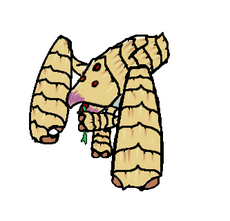
progenitor: Sandoni
Some Sandoni have became heavier in order to defend itself better. It's frontlegs were covered in chitinious material. Heavy sandonis hind legs became stronger to support itself. They became more compact in order to defend itself easier. In the desert they have constant problems with wespars so their backs have became hardened with chitinious armor against aerial attacks. Their forearms became bigger and stronger in order to be able to defend itself against everything. With the bigger body comes bigger hunger. Rockdonis no longer sustained itself with mere sap or blood. Their mouth hardened into peak to eat whole plants or carcasses. With Rockdonises center of gravity gone forward with its stomach, its hind legs have also gone lower and more forward to keep itself stable.
Green Sandoni[edit]
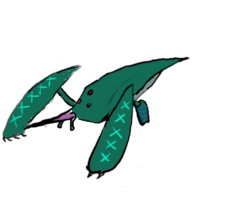
progenitor: Rockdoni
-> Stalker Sandoni
-> Left Sandoni
An offshoot of the Rockdonis mid-way through their development. Some Rockadonis living in the oasis adapted their colouring and body patterns to hide among the creeper cho. At the same time they developed a preferential taste for blood, becoming ambush predators. Some Leaf Sandonis have taken to the shallows of the oasis becoming Stalker Sandonis. Their legs and beak growing longer to better hunt Water Usmals.
Stalker Sandoni[edit]

progenitor: Green Sandoni
The stalker sandosis died out in all but the most permanent oasis. Some of them took to sand becoming Desert Stalkers, their long legs masking their presence from the sand worms. Their walking style produces minimal vibrations, thus the ever present sandworms rarely attack them. They grew in size. They moved during the night. Their proboscis developed into a sharp multi-jointed needles to pierce the bodies of their prey. They also developed long feelers to detect potential prey. They stalk their prey during the day and kill it during the night by piercing it's vital organs, such as spine or brains. They evolved vicous 4-pronged claws to attack in a more vicious manner. They hold down their sleeping prey, ripping open carapace of more heavily armored meals, and digging shallow holes to get at buried prey. By vibrating its ear bones it produces high pitched screeches to communicate over long distances. They hunted in packs.
Leaf Sandoni[edit]

progenitor: Green Sandoni
-> Titandonis
The Sandoni that stay on the shore developed flat leaf like bodies. Their forelimbs increased in size and strength. They developed small barbs to grab prey. The largest of there kind survived over the next generation and grew large claws. The biggest development were the Cho plants on there backs, hatchlings seek out seedlings to attach their roots to their backs. The Cho plants act as lures to help the Sandoni hunt.
The Cho Sandoni developed a symbotic relationship with the Leaf Sandoni. The leaf Sandoni developed tendrils to suck water. With hostile fauna in the desert, the Leaf Sandoni began seeking shelter near large rocks. They were capable of crossing the desert at a bounding gait.
Titandonis[edit]

progenitor: Leaf Sandoni
In response to predators and severe sandstorms they grew huge, now carrying several Cho plants. The Titandonis grow a conical hump, to allow more room for more Cho plants to grow. The Cho roots tap into the creatures blood stream sharing nutrients between the two. The Cho plants now provide over half of the Titandonis energy needs, allowing the creature to wander the desert in search of water for the plant. Cho photosynthetic cells now populate the Titandonis body, providing enough sustenance that they can go months without eating. This allowed them to grow throughout their lives to be truly massive. They are more prone to injury as their exoskeltons can't keep up with the weight in old age.
When a sandstorm hits they hunker down using their legs to protect the plants on their backs. They developed an extra set of legs to gait softer making them harder for sandworms to detect. When the Eruptions happened, they caught falling ash with the Cho roots. The Titandonis developed the habit of wandering the edge of the lava flows to fertilise their Cho plants. The access to new minerals via the plants allowed the Titandonis to strengthen its exoskeleton and attain even greater size.
Usmal[edit]
Sandcoral Usmal[edit]

progenitor: Usmal
Some of Usmal diverged to secrete a watery mucus which quickly dries sand into a hard material. Tall stalks can be found where they dig into the sand to make their homes. When Oasises disappeared during the dry seasons these sandcorals remained marking where the Oasis would return. In response to shifting sands, the muscus became stronger to support tall sand towers. Abandoned usmal tunnels made excellent shelter for other creatures while still young. Their bodies have became streamlined with a thinner body and eye-stalks which protrude forward. Their tendrils became dry and grew hair. By rubbing the them together, they create a high-pitch chirping noise, which is used for echolocation, in addition to a mating call.
They developed a gland in their mouths that squirts their mucus. When their mucus contacts the air it quickly hardens to a flying pin. They fired these pins to deter predators. Their digestive acids mixed with these pins to irritate targets. In preparation to the mating season, Sandcoral usmals undergo a metamorphosis where they gain a pair of wings. They fly across the desert to find mates and a suitable location to lay their eggs. Every four months, the skies are filled with these them. They are nocturnal.
Sandfish Usmal[edit]
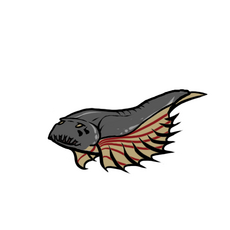
progenitor: Usmal
Some Usmal surivied a long time sucking nutrients from the deepest Cho roots; these Usmal resurfaced. Their stalked eyes sunk to for low light levels of the underground. To shield their sensitive eyes, the sub-usmal's eyes shrank and their brow protruded into a visor. Their legs multiplied and bent backward. They became struts for body-length fins, letting them glide trough the sand like water. Their tail extended under it. They lost most of their pigment. Their skin darkens. Their mouth developed rough edges and became suckers to gnaw on the base of plants.
Amber Usmal[edit]
progenitor: Usmal
-> Ambush Usmal
-> Aquatic Usmal
In response to increased predation from Wespars, Sand Devils and Spade Burrogs. The Usmal developed a novel strategy, taste terrible. Usmal blood became incredibly disgusting. Their legs divided into subgroups for a new method of locomotion. Later on the Amber Usmal's legs merged completely and grew long fingers to hop on the sand. Their toes also became longer to balance their weight easier. Their eyes grew wider to enhance peripheral vision. Their body became slimmer and legs longer to run even faster. Their color changes to yellow to hide better during the day. The amber usmals developed a leathery sail on their back to regulate heat. Their mouths also grew thinner and could be sealed against the sand.
Pusmal[edit]

progenitor: Usmal
-> Rusmal
-> Tusmal
Some of the usmal became scavengers in the harsh desert and changed their color. They developed thicker legs to walk the sands. Their upper bodies grew shoulders and heads to watch for flying predators. To survive during the dry season, they developed water storing humps. Unforunately, these humps made they attractive targets for predators. They evolved facial mouths and teeth to better scavenge corpus. Usmal reproduction became controled by the Pusmal Queens. In time the Queens produced serveral sub-specsis by bio-engineering their own unborn. They evolved a pair of arms for their own advantage. They built walls to protect the nest from magma.
Aquatic Usmal[edit]
progenitor: Amber Usmal
Webbed membranes grew between Usmal toes to facilitate swiming in safe waters from predators. The Aquatic Usmal developed back fins increased the length of their legs. In response to the dry season, they spun themselves into cocoons of saliva and mud until the oasis returns. They hibernate centimetres beneath the dry bottom. These cocoons remain up to a year with the Usmal completely helpless. To comsume more Kaskus flowers, they developed iron-reinforced claws, and barbs on their fore-feeders. The Usmal secrete a sticky copper based resin used to weigh down the hollow bulbs of the Cho. They hide in the Cho bulb during Wespar raids. They form social groups due to several living in the same plant. They developed a small chest which flushes when the Usmal senses a threat, sending others into the Cho bulb. The Usmal secreted a sticky, copper-based resin that they use to weigh down the large, hollow bulbs of a new type of Cho.
Ambush Usmal[edit]
progenitor: Amber Usmal
Some of Usmal developed natural cloaking. There bodies become more agile to help them hunt. Due to seasonal oasises drying up, they wander the deserts at night. They became fearsome predators hunting in packs. They gained markings unique to each pack. To regulate heat, they grew thick scales along their body. They grew poisonious fangs that stun their targets. Their mouths grew wider. Their feelers were replaced with whiskers to detect vibrations. They developed hyper sensitive ears to allow echolocation.
Frilled Ambush Usmal[edit]

progenitor: Ambush Usmal
The Usmal evolved a frill like a satellite dish letting them hear long distances. It amplified their echolocation. The frills flex up and down. This emits sonic pluses blocking out heat and sound they produce. They grew bigger and slowed down their movement speed. They grew strong legs and backs. They started walking a on two legs. They use subsonic rattles to communicate over long distances. They began to live in tight packs that hunt and raise young together.